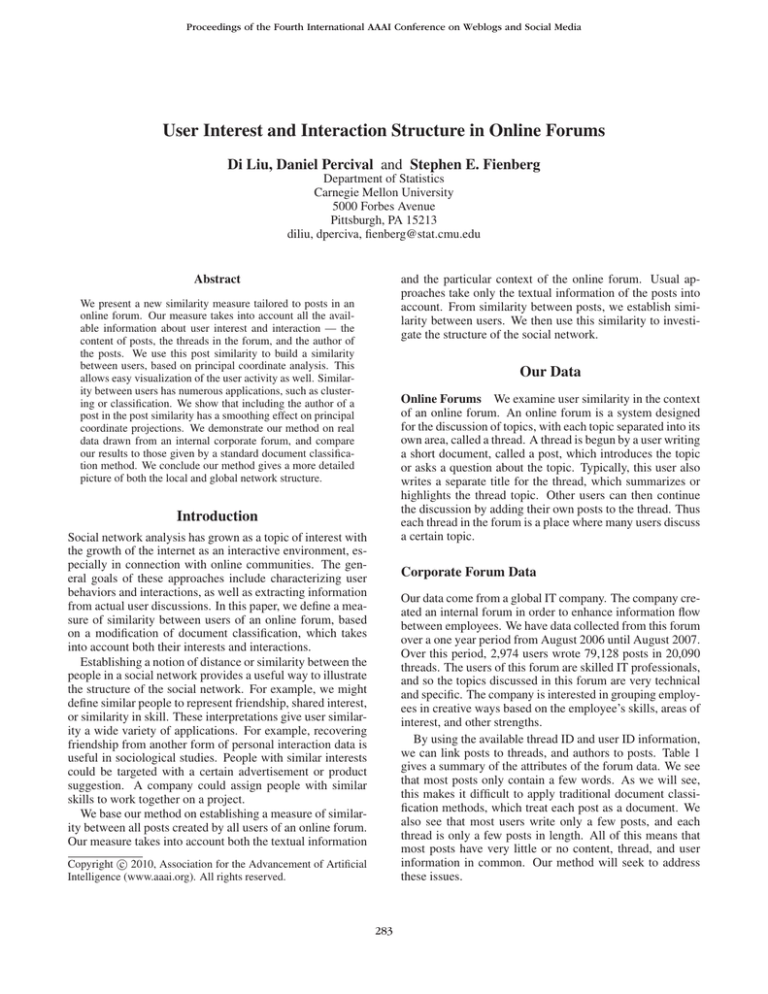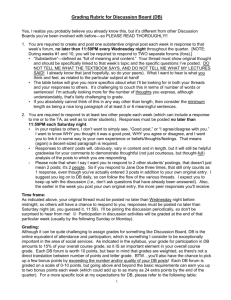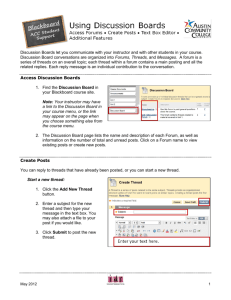User Interest and Interaction Structure in Online Forums
advertisement

Proceedings of the Fourth International AAAI Conference on Weblogs and Social Media
User Interest and Interaction Structure in Online Forums
Di Liu, Daniel Percival and Stephen E. Fienberg
Department of Statistics
Carnegie Mellon University
5000 Forbes Avenue
Pittsburgh, PA 15213
diliu, dperciva, fienberg@stat.cmu.edu
and the particular context of the online forum. Usual approaches take only the textual information of the posts into
account. From similarity between posts, we establish similarity between users. We then use this similarity to investigate the structure of the social network.
Abstract
We present a new similarity measure tailored to posts in an
online forum. Our measure takes into account all the available information about user interest and interaction — the
content of posts, the threads in the forum, and the author of
the posts. We use this post similarity to build a similarity
between users, based on principal coordinate analysis. This
allows easy visualization of the user activity as well. Similarity between users has numerous applications, such as clustering or classification. We show that including the author of a
post in the post similarity has a smoothing effect on principal
coordinate projections. We demonstrate our method on real
data drawn from an internal corporate forum, and compare
our results to those given by a standard document classification method. We conclude our method gives a more detailed
picture of both the local and global network structure.
Our Data
Online Forums We examine user similarity in the context
of an online forum. An online forum is a system designed
for the discussion of topics, with each topic separated into its
own area, called a thread. A thread is begun by a user writing
a short document, called a post, which introduces the topic
or asks a question about the topic. Typically, this user also
writes a separate title for the thread, which summarizes or
highlights the thread topic. Other users can then continue
the discussion by adding their own posts to the thread. Thus
each thread in the forum is a place where many users discuss
a certain topic.
Introduction
Social network analysis has grown as a topic of interest with
the growth of the internet as an interactive environment, especially in connection with online communities. The general goals of these approaches include characterizing user
behaviors and interactions, as well as extracting information
from actual user discussions. In this paper, we define a measure of similarity between users of an online forum, based
on a modification of document classification, which takes
into account both their interests and interactions.
Establishing a notion of distance or similarity between the
people in a social network provides a useful way to illustrate
the structure of the social network. For example, we might
define similar people to represent friendship, shared interest,
or similarity in skill. These interpretations give user similarity a wide variety of applications. For example, recovering
friendship from another form of personal interaction data is
useful in sociological studies. People with similar interests
could be targeted with a certain advertisement or product
suggestion. A company could assign people with similar
skills to work together on a project.
We base our method on establishing a measure of similarity between all posts created by all users of an online forum.
Our measure takes into account both the textual information
Corporate Forum Data
Our data come from a global IT company. The company created an internal forum in order to enhance information flow
between employees. We have data collected from this forum
over a one year period from August 2006 until August 2007.
Over this period, 2,974 users wrote 79,128 posts in 20,090
threads. The users of this forum are skilled IT professionals,
and so the topics discussed in this forum are very technical
and specific. The company is interested in grouping employees in creative ways based on the employee’s skills, areas of
interest, and other strengths.
By using the available thread ID and user ID information,
we can link posts to threads, and authors to posts. Table 1
gives a summary of the attributes of the forum data. We see
that most posts only contain a few words. As we will see,
this makes it difficult to apply traditional document classification methods, which treat each post as a document. We
also see that most users write only a few posts, and each
thread is only a few posts in length. All of this means that
most posts have very little or no content, thread, and user
information in common. Our method will seek to address
these issues.
c 2010, Association for the Advancement of Artificial
Copyright Intelligence (www.aaai.org). All rights reserved.
283
Table 1: A summary of the attributes of the corporate forum data. Note that the post word counts include stopwords.
Attribute
Words in a Post
Posts made by a User
Posts in a Thread
Min
1
1
1
1st Quartile
14
1
2
Post 2
Post 3
Post 4
3rd Quartile
59
22
5
Max
8980
975
265
it appears. This makes posts within the same thread more
similar in word content and therefore closer in cosine similarity.
Posts made in the same thread might share little or no
words in common, even though they are on the same
topic. Such posts would not be considered related under
usual cosine similarity. Table 2 illustrates this problem
via an example of a typical thread in our data set.
We use the thread titles since they roughly represent the
topic of the thread. Additionally, a user typically only
reads the title of the thread before deciding to read the
rest of the thread and then possibly making a response
post. Therefore, the thread title captures both post topic
and user interests.
Table 2: A sample thread from the corporate forum data set.
Here the posts in the thread do not share many words in common. Traditional document classification methods would
therefore consider these posts nearly unrelated.
Post 1
Median
28
5
3
Thread Title: Madriva 2007 3D desktop
Anybody tried mandriva 2007? Its cool with
a XGL 3D desktop.. But is hungry for RAM..
You should give ubuntu 6.10 (or the 7.04 dev)
a try. You might also find this interesting:
[HYPERLINK]
And lookout for KDE Plasma. More info in :
[HYPERLINK]
Here are few resources on getting Beryl
(beryl.. is extremely irresistable.. enter at
your own risk :-) )
[HYPERLINK] [HYPERLINK] [HYPERLINK] (best of all)
• We modify the tf-idf(D, j) measure of word importance
to take into account the thread in which a document D
appears - see (Weiss et al. 2005) for a full description
of tf-idf. tf-idf measures word importance only using the
overall frequency of a word. However, if a word appears
often in a particular thread, then it is likely to be of particular importance to the thread topic, whether or not it
is a common word in an overall sense. Table 3 gives an
example of a thread which illustrates this point.
We define T (D) to be the document consisting of the concatenation of all posts in the thread containing document
D. We then define:
Method
Our method consists of two main steps. In the first step,
we create a matrix which measures the similarity between
all pairs of posts in the forum. In the next step, we build
a similarity matrix for users by creating a coordinate system
based on the similarity matrix from the first step. The results
of this second step allow us to examine the structure of the
relationships and activity of the forum users.
dfT (D) (j) =
Measuring Similarity Between Posts
df(j)
.
tf(T (D), j)
Which gives us the following formula, where N is the
total number of documents:
If we consider each post as a document, then our goal is
to establish a notion of similarity between the documents.
Methods such Latent Dirichlet Allocation (LDA) (Blei, Ng,
and Jordan 2003) and cosine similarity (Weiss et al. 2005)
have been shown to be effective document classification
techniques. Since we wish to establish a numerical measure
of post similarity, we will modify cosine similarity.
Cosine similarity is insufficient for analyzing forum data.
Cosine similarity is based on word overlap, and is most effective when applied to long documents. However, a typical
forum post is only a few sentences long. Additionally, cosine similarity mistreats or ignores information available by
considering the threads and the author of the posts. These
two issues result in a very sparse similarity matrix — many
documents intuitively related by thread or author have no
relation at all.
To address these problems, we modify cosine similarity as
follows to take into account all of the available information
in forum posts:
tf-idfT (D) (D, j) = tf(D, j) × log2 (N/dfT (D) (j)). (1)
This new measure takes into account the importance of
a word within a thread. Examining the original df(j)
measure, we see that as df(j) increases, the importance
of word j goes down. Dividing by the thread word frequency tf(T (D), j) means dfT (D) (j) decreases as a word
becomes more common within a thread.
Note that in combination with the previous point, we have
that the words in the thread title are of great importance to
the thread topic. Since the thread title usually represents
the topic, this is a desirable effect.
• After computing the cosine similarity using the above
modifications, we add an additional term to capture our
belief that documents authored by the same user are similar. Since we want this term to be independent of both
post content and the particular user, this term should be a
universal constant.
• We append to each post the title of the thread in which
284
8 Users: First Two Principal Coordinates
(Full Similarity Measure)
Table 3: A sample thread from the corporate data set. Here
the words “data” and “migration” appear frequently in the
posts. Therefore, within this thread, these words should be
given high importance. In the usual tf-idf framework, these
words would be given high importance only if they were
relatively rare throughout the forum.
Post 3
Post 4
●
Pr nc pa Coord nate 3
Post 1
Post 2
2.0
Thread Title: data migration
Basically what is data migration?
Data migration, basically means to porting data from one environment (format/OS/Database/Server etc) to other
environment.
The process of translating data from one format to another. Data migration is necessary when an organization decides to use new
computing systems or database management
system that is incompatible with the current
system. Typically, data migration is performed by a set of customized programs or
scripts that automatically transfer the data.
Migrating to higher version also one of the
part in data migration.
1.5
5
●
1.0
0.5
●
3
●
7
●
6
0.0
−0.5
User 1
User 2
User 3
User 4
User 5
User 6
User 7
User 8
●
●
●
●●
●●
●
●
●●
●●●
●
●
● ●
●
●
●
●
●●
●
●
●
●
●
●●
●
●●
●
●
●●
●
●
●
●
●
●
●
●●
●●●
●● ●
●●
●
●●
●●●
●
●
●
●
●
●
●●
●
●
●
●
●
●●
●
●●
●
●
●
●
●
●●
●
●
●
●
●
●
●
●
●
●
●
●
●
● ●
●● ●
●● ●
● ●●●
●●●
●
●
8
●
4
●
2
1
−1.0
−0.5
0.0
0.5
1.0
1.5
2.0
Principal Coordinate 2
Figure 1: The second and third principal coordinates for the
8 user data set. The centroids are given by the numbers in
the white circle. We can clearly see each user separately,
but are still able to see spread information and the similarity
between users.
Our goal is not to cluster posts or to assign posts to users.
Rather, we are interested in examining the relationships
between users. This term does not affect the distance of
posts written by different users. Therefore, the inclusion
of an author term is not a circular step. This term has a
smoothing effect – it reduces the within group variance
for each user.
Therefore, in order to visualize this result and to facilitate
further computation, we find a low dimensional representation of the posts which preserves the geometry implied by
the original dissimilarity matrix. We achieve this via principal coordinate analysis (Hastie, Tibshirani, and Friedman
2001).
Towards the main goal of this paper, we can also use this
representation to characterize users. We can give each user
a single set of coordinates by finding the centroid of all that
user’s posts in this low dimensional space. This roughly
gives us a center which follows the areas of high density.
The universal author constant λ reduces the variance of the
centroid, which is the estimator of the position of the user in
this space.
Using these centroids, we can simply make a distance matrix between users by taking the euclidean distance between
all pairs of user centroids. This distance matrix can characterize the social network structure in a wide variety of ways,
such as clustering, spanning trees, or nearest neighbor methods.
We therefore modify the cosine similarity equations by
replacing df(j) with dfT (D) (j), and by replacing each post
D with post D∗ , which has the thread title appended. We
define the function U (D) to return the author of post D. We
then define:
sim(D1 , D2 ) = cosineT (D) (D1∗ , D2∗ ) + λI{U (D1 )=U (D2 )}
(2)
(3)
dist(D1 , D2 ) = max (0, 1 − sim(D1 , D2 )) .
Here, λ is our universal author constant as discussed
above and cosineT (D) (D1 , D2 ) represents the cosine distance, with the modified tf-idf measure given in equation 1
replacing tf-idf in both the distance and the norms. We then
convert the similarity measure in equation 2 to a dissimilarity measure via equation 3. Note that the maximum of the
cosine similarity measure is 1. This formula is applied to all
pairs of posts, giving us a dissimilarity matrix between all
posts.
Results
Illustration: A Small Set of Active Users
In order to illustrate our method clearly and intuitively, we
present results for a small set of users. We consider all users
who wrote between 200 and 210 posts on the forum. In the
full dataset, the set of users who wrote more than 200 posts
accounts for about 50% of all posts. Therefore, this range
represents users who are roughly in the middle in terms of
posting activity. These users are also easier to compare since
they wrote roughly the same number of posts. This range
Measuring Similarity Between Users
We now seek to create a dissimilarity matrix between all
users in the forum, given the dissimilarity matrix between
all the posts. We first seek to visualize the relative position
of all the posts in some low dimensional space. Note that
our dissimilarity matrix only gives us a function of the position of the posts, it does not give the coordinates directly.
285
gives us eight users in total.
Using only the subset of posts authored by these users, we
apply our previously described method. Note that the dictionary is built from all of the posts, so the tf-idf measures take
into account the overall importance of the words. Therefore, the tf-idf measures are not biased in this case, and so
our results for these particular users will not differ greatly
from those obtained when all of the posts are included in the
analysis.
Figure 1 shows the second and third principal coordinates
for the posts. We use λ = 0.059 for our universal author
similarity constant. This is the 75th quantile of our nonzero
similarities obtained without taking author into account. We
can see a clear separation between users, as well as differing spreads for each user. Looking at the centroids, we see
six users who are somewhat similar, and two users who are
separated by these principal coordinates. These two users
also seem to have larger spreads than the other six, which
possibly indicates a broader interest in topics.
To illustrate an application of the user distance, we next
build a hierarchical clustering tree using complete linkage (Hastie, Tibshirani, and Friedman 2001). From this tree
we see that there are two main clusters: users {1, 5} and
users {2, 3, 4, 6, 7, 8}. This is consistent with our earlier display of the users in Figure 1. This clustering gives a picture
of the network structure within this 8-user group.
Complete Linkage Clustering Dendrogram
(Post Based Distance)
1.2
1.0
Height
0.8
0.6
37
0.4
46
0.2
6
24
62
0.0
14
30
1952
54
67
29 63
3661 25 53 2232
68 15 5138 35
50
12
7 2639
60
9
33
4
31
58
28
41
42
69
55
2
48
47
10
64 49
66 40
23 113 13
71
20
45
59 341 43
16
44
56
8
65
57
18
5
27
17
2170
Figure 2: Cluster dendrogram for the 71 users. We can create a clustering by drawing a horizontal line at any height
in the tree, and taking the clustering given by the links below the line. Overall, we see that five clusters seems most
appropriate.
rums. We discussed the properties of our modification, and
presented some results on a real data set.
Users in a forum demonstrate their interests and interactions with other users in two ways. First, users write
posts whose words can tell us in which topics they are interested. Second, users post in particular threads, indicating
both topic interest and interaction with the other users who
have already posted in the thread. By including the title of
threads in each post, we view both types of information in a
single unified context. User interactions within a thread are
transformed into shared words.
In our database, thread titles tend to be very short once
we remove stopwords. Therefore, the longer the post, the
smaller the effect of the thread title on cosine similarity.
Since longer posts contain more textual information, this is a
desirable effect. Our modification give us information about
posts which are otherwise hard to characterize.
We need a more systematic way to pick the author constant λ. We believe λ also has beneficial properties with regard to statistical testing. We would like to develop a framework to investigate these properties. Different estimators of
user location besides the centroids proposed in this paper
may lead to more rich estimators of user distance. We are
also interested in additional validation of this method on data
with some known and recoverable social structure.
Active Users
We now consider a large set of active users in the corporate forum data set. We take all users who wrote between
200 and 400 posts on the forums. This gives us 71 users
and 18,682 total posts. We consider this subset for computational and interpretive reasons.
We apply our method to these 71 users, with λ = .054.
This λ is obtained from the 75th quantile of the nonzero similarity matrix entries for the modified cosine similarity measure. Due to the large number of users in this data set, plots
of the principal coordinates do not give clear pictures of the
relationships between users. Note that plots of subsets of
users can show individual user spread.
As mentioned before, there are many ways to look at the
social network structure once we calculate the distance between all of the users. We present a well-known examples
here: complete linkage clustering.
Figure 2 shows the complete linkage hierarchical cluster
dendrogram for the 71 users. We see that a five cluster solution looks appropriate. The majority of the users are in
two of these five clusters. The remaining three groups are
small and separated from these two large groups. In particular, we see a group of three users located far away from the
other four groups. This group may represent a collection of
users who have the same specialized interest. The two large
groups perhaps deal with general or popular topics.
References
Blei, D. M.; Ng, A. Y.; and Jordan, M. I. 2003. Latent
Dirichlet Allocation. Jornal of Machine Learning Research
3:993–1022.
Hastie, T.; Tibshirani, R.; and Friedman, J. 2001. The Elements of Statistical Learning. Springer.
Weiss, S. M.; Indurkhya, N.; Zhang, T.; and Damerau, F. J.
2005. Text Mining. Springer.
Discussion
Our main contribution is a new similarity measure between
posts in a forum. This measure effectively modifies document similarity to incorporate the special structure of fo-
286





